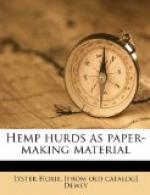HEMP HURDS AS PAPER-MAKING MATERIAL.
By Lyster H. Dewey, Botanist in Charge of Fiber-Plant Investigations, and Jason L. Merrill, Paper-Plant Chemist, Paper-Plant Investigations.
=Contents.=
Page.
The production and handling of hemp hurds,
by Lyster H. Dewey:
What hemp hurds are 1 Pith, wood, and fiber 2 Character of hurds affected by retting 2 Proportion of hurds to fiber and yield per acre 3 Hurds available from machine-broken hemp 3 Present uses of hemp hurds 4 Present supplies of hurds available 5 Baling for shipment 5 Cost of baling 5 Summary 6
The manufacture of paper from hemp hurds,
by Jason L. Merrill:
Introduction 7 Factors justifying an investigation of hemp hurds 8 Character of the material 11 Character of the tests 12 Operations involved in a test 13 Description of tests 16 Comparison of the tests and commercial practice 21 Physical tests of the papers produced 24 Conclusions 25
In preparing the report on the manufacture of paper from hemp hurds it became evident that a short discussion of the agricultural aspects of this material should be included in the publication. Such an article was prepared, therefore, and the two reports are here presented together.
[Note.—This bulletin should be useful to all persons who are interested in the economic phases of paper making, especially to print and book paper manufacturers. It also should be of interest to scientific investigators and chemists.]
=The production and handling of hemp hurds.=
By Lyster H. Dewey, Botanist in Charge of Fiber-Plant Investigations.
=What hemp hurds are.=
The woody inner portion of the hemp stalk, broken into pieces and separated from the fiber in the processes of breaking and scutching, is called hemp hurds. These hurds correspond to shives in flax, but are much coarser and are usually softer in texture.
The hemp stalk grown in a broadcast crop for fiber production is from one-eighth to three-eighths of an inch in diameter and from 4 to 10 feet tall. The stalk is hollow, with a cylindrical woody shell, thick near the base, where the stalk is nearly solid, and thinner above, where the hollow is relatively wider.




